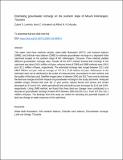Estimating groundwater recharge on the southern slope of Mount Kilimanjaro, Tanzania

View/
Date
2019-12-03Author
Lwimbo, Zuberi
Komakech, Hans
Muzuka, Alfred
Metadata
Show full item recordAbstract
This paper used three methods namely: water-table fluctuation (WTF), soil moisture balance (SMB), and chloride mass balance (CMB) to estimate groundwater recharge in a degraded Kahe catchment located on the southern slope of Mt. Kilimanjaro, Tanzania. Three methods yielded different groundwater recharge rates. Results of the WTF method showed that recharge in the catchment was about 248.4 million m3/year, whereas those of CMB and SMB methods were 156.0 and 132.1 million m3/year, respectively. The estimated recharge rates ranged between 132.1 and 248.4 million m3/year with an average of 191.34 ± 27.80 million m3/year. Differences in the estimated rates can be attributed to the scales of measurements, assumptions in each method, and the quality of the data used. Satellite images taken in between 2000 and 2017 were used to estimate the land-use changes and their impacts on groundwater recharge in the study catchment. Analyzed satellite images showed that over the 17-year period, natural forests and bushes and shrubs decreased by 3.6 and 4.1%, while agricultural land and built-up area increased by 12.8 and 0.8%, respectively. Using SMB method, we found that these land-use changes have contributed to a decrease in groundwater recharge of about 42% between 2000 and 2017 (i.e., from 227.8 to 132.1 million m3/year). The findings from this study are useful for assessing the potential impacts of land-use change on water resources in the catchment.
